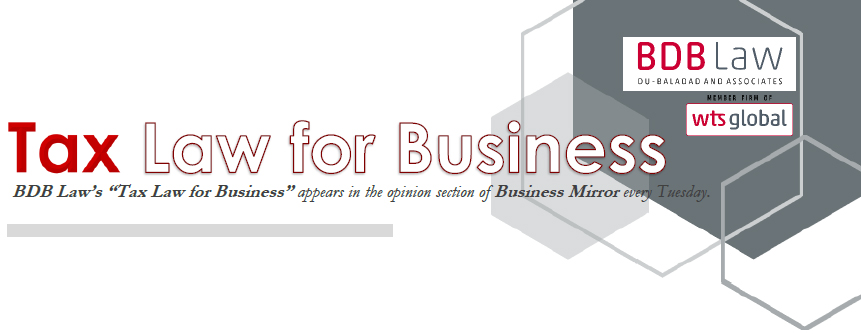
Using Artificial Intelligence in Tax Administration
By: Atty. Jomel N. Manaig
"In the Tax Administration Series (TAS) 2023, the Organisation for Economic Co-operation and Development (OECD) reported that 2022 data from 52 jurisdictions reveal that around 50% of tax administrations use AI in risk assessment processes and detection of tax evasion and fraud. This is a significant increase from just 38% in 2019."
Atty. Jomel N. Manaig
Partner
+632 8403-2001 loc. 140
This email address is being protected from spambots. You need JavaScript enabled to view it.
View Profile
|
Sometime in February 2023, I wrote an article on what I see are broad-stroke opportunities of artificial intelligence (AI) in tax. Fast forward to today, it is refreshing to witness that some of these outlooks are crossing the realm of reality. More and more, the presence of artificial intelligence is being felt in the world of taxation and this AI revolution or disruption, whichever way you look at it, is happening in different jurisdictions.
In the Tax Administration Series (TAS) 2023, the Organisation for Economic Co-operation and Development (OECD) reported that 2022 data from 52 jurisdictions reveal that around 50% of tax administrations use AI in risk assessment processes and detection of tax evasion and fraud. This is a significant increase from just 38% in 2019.
 One of the major sections of TAS 2023 is the Tax Administration 3.0 vision which is being used by tax administrations as a guide to drive their digital transformation strategies. It identifies a series of core building blocks that are the critical components of digital transformation.
One of the major sections of TAS 2023 is the Tax Administration 3.0 vision which is being used by tax administrations as a guide to drive their digital transformation strategies. It identifies a series of core building blocks that are the critical components of digital transformation.
Supporting taxpayer compliance. This focuses on creating positive taxpayer attitudes when it comes to tax compliance. The goal is to make it as easy and seamless as possible for taxpayers to meet tax obligations. The easier it is for taxpayers to comply, the easier it is for tax administrators to raise public funds. The initiatives being taken by tax administrations are:
1. Creating a 24/7 tax administration to make it easier for taxpayers to contact the tax administrators and improve the reactive processes. This initiative is also supplemented by proactive programs through social media to educate taxpayers.
For example, tax administrations in Italy, Australia, and Georgia, to name a few, made use of technology and AI to transform their operational models to respond to feedback from taxpayers. Other countries like Canada, Japan, and the Netherlands utilized technology and AI to support taxpayer self-service. Virtual assistants and chatbots have likewise appeared in Portugal and the US to respond to taxpayer queries.
On the other hand, Brazil made use of technology to communicate to the taxpayers the economic importance of taxes.
2. Leveraging on digital identity and verification allows tax administrations to maximize the use of online and digital platforms while ensuring the safety of the data of taxpayers. Identity verification and authentication may come in various forms like multi-factor authentication and biometric verification (facial recognition and/or fingerprint).
In Japan and Mexico, smartphones and digital authentication systems are being used to verify and validate identification and biometric data. The Czech Republic chose to involve different government agencies to enable data sharing between different agencies.
3. Tax administration services are starting to be decentralized by embedding services and processes in the natural systems used by taxpayers on a daily basis. This decentralization even extends to allowing access to tax administration internal systems through application programming interface (API). It allows connectivity without providing direct access.
China has been developing a system, based on a fully digitized e-invoice, which explores the practice and effects of seamless tax administration. It integrates business, finance, and taxation through an invoice data model without third-party API providers.
Reducing taxpayer burdens. Another core building block is the reduction of taxpayer burdens by using and analyzing data to adopt a preventive approach to taxpayer compliance risk management. This approach relies on intervening at earlier stages in taxpayer processes to avoid and prevent noncompliance from happening and having it uncovered after tax returns have been filed.
In Canada, advanced analytics (including machine learning and deep learning) are being tested for identifying high-risk small and medium businesses for audit. Data analytics are likewise being used in Australia, Chile, and Israel to aid in tax administration processes. On the other hand, realizing that paper forms would still be needed in the years to come, Sweden is using artificial intelligence to interpret handwritten text on paper tax returns.
In the Philippines, we have seen some advancements of our own in the past few years: 1) several portals released for the BIR’s various e-services; 2) the chatbot Revie; and 3) electronic modes of filing and payment. But there are also some initiatives which do not appear to have gone past the birth pain stage (i.e. the e-invoicing system).
With the BIR’s thrust for continued digital transformation, we hope they take note of TAS 2023 and successfully leverage on the practices and experiences of other countries.
The author is a partner of Du-Baladad and Associates Law Offices (BDB Law), a member-firm of WTS Global.
The article is for general information only and is not intended, nor should be construed as a substitute for tax, legal or financial advice on any specific matter. Applicability of this article to any actual or particular tax or legal issue should be supported therefore by a professional study or advice. If you have any comments or questions concerning the article, you may e-mail the author at This email address is being protected from spambots. You need JavaScript enabled to view it. or call 8403-2001 local 140.


 One of the major sections of TAS 2023 is the Tax Administration 3.0 vision which is being used by tax administrations as a guide to drive their digital transformation strategies. It identifies a series of core building blocks that are the critical components of digital transformation.
One of the major sections of TAS 2023 is the Tax Administration 3.0 vision which is being used by tax administrations as a guide to drive their digital transformation strategies. It identifies a series of core building blocks that are the critical components of digital transformation.


